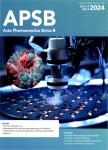Mitochondrial-targeted and ROS-responsive nanocarrier via nose-to-brain pathway for ischemic stroke treatment
作者机构:Tianjin Key Laboratory of Biomedical MaterialsInstitute of Biomedical EngineeringChinese Academy of Medical Sciences&Peking Union Medical CollegeTianjin 300192China State Key Laboratory of Component-based Chinese MedicineResearch Center of Traditional Chinese MedicineTianjin University of Traditional Chinese MedicineTianjin 301617China
出 版 物:《Acta Pharmaceutica Sinica B》 (药学学报(英文版))
年 卷 期:2023年第13卷第12期
页 面:5107-5120页
核心收录:
学科分类:1007[医学-药学(可授医学、理学学位)] 1002[医学-临床医学] 10[医学]
基 金:supported by National Natural Science Foundation(82272154,China) Tianjin Science Fund for Distinguished Young Scholars(22JCJQJC00120,China) Natural Science Foundation of Tianjin(The Basic Research Cooperation Special Foundation of Beijing-Tianjin-Hebei Region,H2022205047,22JCZXJC00060,and E3B33911DF,China) the Fundamental Research Funds for the Central Universities(3332021068,,3332020059,2019PT320028,and 2021-RC310-005,China) the CAMS Innovation Fund for Medical Sciences(2021-I2M-1-058,and 2022-I2M-2-003,China).
主 题:Ischemic stroke Inflammation Mitochondrial targeted Multifunctional nanocarriers Nose-to-brain pathway Oxidative stress Puerarin ROs-Responsiveness
摘 要:Oxidative stress injury and mitochondrial dysfunction are major obstacles to neurological functional recovery after ischemic stroke.The development of new approaches to simultaneously diminish oxidative stress and resist mitochondrial dysfunction is urgently needed.Inspired by the overproduced reactive oxygen species(ROS)at ischemic neuron mitochondria,multifunctional nanoparticles with ROS-responsiveness and mitochondrial-targeted(SPNPs)were engineered,achieving specific targeting delivery and controllable drug release at ischemic penumbra.Due to the nose-to-brain pathway.SPNPs which were encapsulated in a thermo-sensitive gel by intranasal administration were directly delivered to the ischemic penumbra bypassing the blood-brain barrier(BBB)and enhancing delivery efficiency.The potential of SPNPs for ischemic stroke treatment was systematically evaluated in vitro and in rat models of middle cerebral artery occlusion(MCAO).Results demonstrated the mitochondrialtargeted and protective effects of SPNPs on H2O2-induced oxidative damage in SH-SY5Y cells.In vivo distribution analyzed by fuorescence imaging proved the rapid and enhanced active targeting of SPNPs to the ischemic area in MCAO rats.SPNPs by intranasal administration exhibited superior therapeutic efficacy by alleviating oxidative stress,diminishing infammation,repairing mitochondrial function,and decreasing apoptosis.This strategy provided a multifunctional delivery system for the effective treatment of ischemic injury,which also implies a potential application prospect for other central nervous diseases.



